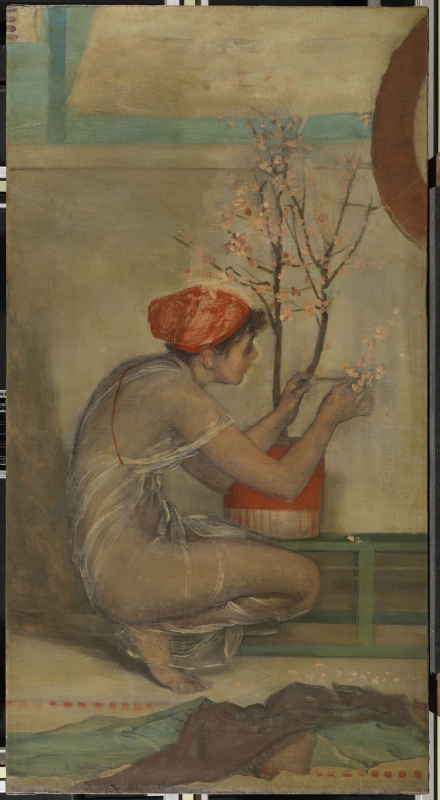Provenance
- 1879/1880: bought either from Whistler or Messrs Dowdeswell by Charles Benjamin Bright McLaren (1st Lord Aberconway) (1850-1934) , first Lord Aberconway;
- 1934: after his death, sold at auction, Robinson & Fisher, London, 5 April 1934 as 'Almond Blossoms', and bought by his son, Henry Duncan McLaren, 2nd Lord Aberconway (1879-1953) , 2nd Baron Aberconway, for £483.0.0;
- 1953: bequeathed to his second son, Christopher Melville McLaren (b. 1934) ;
- 2015: on long term loan from a private collection to the Courtauld Institute of Art.
According to the Pennells, 22 February 1878 Charles Augustus Howell (1840?-1890) recorded in his diary the purchase of five paintings from Whistler for £50.0.0, including 'a large picture of apple blossoms.' 1 This 'large picture' may have been Girl with Cherry Blossom [YMSM 090], which is thought to have been cut from the central section of The Three Girls [YMSM 088], and if the Pennells got the diary entry date right, this means The Three Girls was cut up in or before February 1878. In which case Howell could have sold the fragment, either on his own behalf, or acting as an agent, either directly or through an art firm such as Messrs Dowdeswell.
However, this scenario is contradicted by the record of a journalist, who saw The Three Girls, with the canvas still intact, in Whistler's studio in the White House in March 1879. 2 Whistler was declared bankrupt in May 1879. By 1880, he was trying to locate the whole, unfragmented canvas and mentioned that he had left it in the White House in the previous year, expecting it to be sold at his bankruptcy sale. It was not sold and he suspected Howell might have had a hand in removing it, as he wrote, 'The 3 girls may be in pawn or otherwise disposed of by Howell, or kept by him for future transaction!' 3 Thus Whistler thought that Howell could have acquired it (he was one of Whistler's creditors), and pawned or sold it. But did Howell or someone else return the canvas to Whistler in 1880, or later? did Howell or Whistler or someone else cut it up? Was the fragment Girl with Cherry Blossom [YMSM 090] saved and perhaps touched up and sold by the artist?
Family records are contradictory: Christabel Aberconway (1890-1974) thought that Whistler had sold it to her father-in-law, Charles Benjamin Bright McLaren (1st Lord Aberconway) (1850-1934), 'before he married and when he was studying for the Bar' (McLaren became a Barrister at Lincoln's Inn in 1874 and married in 1877). 4 This would imply that Girl with Cherry Blossom [YMSM 090] was cut from the original canvas before 1874, which is unlikely. Charles McLaren, who owned the painting fragment for many years, wrote, 'I bought this picture after [Whistler's] bankruptcy from Dowdeswell, then of Chancery Lane.' 5 This seems slightly more likely: Charles William Dowdeswell (1832-1915) had a print shop at 36 Chancery Lane, London, from 1865 on, and the firm was still there at the time of Whistler’s bankruptcy in 1879 (they had moved to 133 New Bond Street by 1880). Furthermore, Messrs Dowdeswell bought The Gold Scab [YMSM 208] at Whistler's bankruptcy sale in 1879, and could have been involved in moving canvases out of the White House after Whistler left for Venice in 1880.
Exhibitions
- Not exhibited in Whistler's lifetime.
Notes:
1: Pennell 1921C [more] , p. 69; the other paintings may have been Nocturne [YMSM 114] or Nocturne: Blue and Silver - Battersea Reach [YMSM 119], and Study for the Head of Miss Cicely H. Alexander [YMSM 128], Nocturne: Grey and Gold - Chelsea Snow [YMSM 174], and Sketch for a Portrait of Henry Greaves [YMSM 198]. None of these sales have been confirmed.
2: A. de G. S., New York Herald, New York, 18 March 1879.
3: Whistler to H. E. Whistler, [March 1880], GUW #06689.
4: Undated note by the Lady Aberconway, GUL WPP files.
5: GUL WPP files.
Last updated: 15th December 2020 by Margaret





